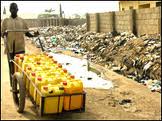Any thoughts of sleeping through the racket is immediately put to bed when a scratchy loudspeaker croaks into life and the taped sermon of an unknown cleric is played at high volume until the call to Morning Prayer. Loud as the speaker already was, the muezzin still used every bit of air in his lungs to scream into the microphone. At the end, rather an innate desire to heed the call, the fierce effort leaves many jumpy and irritable. It is just five o’clock in the morning.
Comparing mechanical blast to that of the former muezzin whose melodious voice rolled down every alley in the community without a loudspeaker is of no use because several high-pitched, wailing motorcycles are already choking into life as the commercial motorcycle business, banned from several cities is finding new applications in rural areas. The cacophony is violent and emissions from the engine oil-mixed with petrol engines, toxic.
Soon after the morning prayers, instead of a quite hour or so before sunrise, hawkers of all kinds of assorted foods and other sundry items begin to advertise their wares with a ferocity that would leave even major global brands aghast. No home, no room and no eardrum is safe from the insistent cry of young girls selling bean cakes, corn gruel, millet drinks, ‘pure water’ and every kind of edible item that can be bought and sold.
With all chances of getting any kind of rest long gone, embarking on the routine of exchanging greetings with family and friends is no consolation because most of them have already left home to begin the day’s hustling. Then news of the previous night’s gruesome attacks filter in from several sources: a local trader had been lured from his home with a business proposal and hacked to death in a nasty machete attack then left to die on a farm; also an armed robbery attack on a highway had left several others critically injured with different kinds of wounds.
After a meal that had as many processed portions as any obtainable in any city, a walk around homes and public spaces revealed that nowhere is immune from the twin disasters of open defecation and the ubiquity of used ‘pure water’ bags. The smell from the former and the eyesore from the latter are sufficient to leave even the most indifferent repulsed and revolted.
In the midst of all these, life seems to continue as usual.
One may be excused to think that he or she had woken up in a grimy slum on the outskirts of any of Nigeria’s major towns or cities which have no facilities that can classify them as urban, but are too noisy and polluted to be termed rural, and whose residents, if anything, would take offense at being called rustics.
Actually, the above scenes were my impressions during a visit to a community that is dozens of miles from the nearest city. It was a jarring introduction to a new phenomenon in Nigeria’s distorted development process, where our urban areas are mere population centres without amenities, while our rural areas have assimilated all the drawbacks of city life without any of the benefits: In the said settlement, there is no modern hospital; schools are very basic; the only tarred road is the ancient potholed motorway that leads in and out; most houses are mud and thatch structures and electricity is weak and epileptic.
The problem, which is largely replicated all over Nigeria is: many rural areas, without any of the benefits one would expect with city life like modern houses, good roads, stable power supply, standard education systems, well–equipped hospitals, potable water supply schemes – and all other conveniences associated with urban life – are assimilating all the negative traits related with urban conurbations. In the said settlement, noise pollution, environmental degradation, crime and other problems seem just as rife among people already emasculated by poverty and the absence of basic infrastructure.
Nigeria’s current population is put at 170 million, and according to the latest revisions in the study, ‘World Urbanisation Prospects’ issued by the United Nations, the country will see the fastest urban population growth in the next 40 years, with its cities expected to add 200 million people, and a total population of about 370 million. With this rapidly expanding population and fast evolving social and economic dynamics, the need for government to appreciate the sociological undercurrents of our negatively ‘urbanized’ rural areas is critical.
The posers for government are: Do we ‘urbanise’ rural areas, or develop urban areas to accommodate rural-urban migration? How do we improve the quality of life, security and plan development projects while avoiding the ills of poorly planned urbanization? How do we protect our environment?
